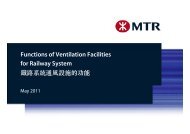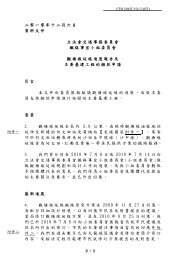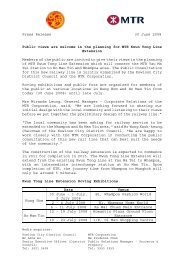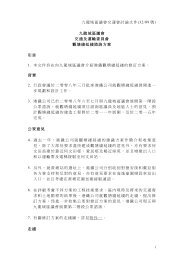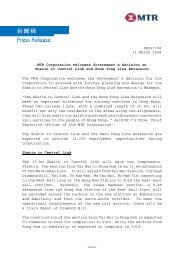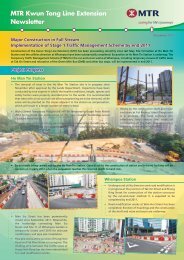legislative council brief kwun tong line extension funding arrangement
legislative council brief kwun tong line extension funding arrangement
legislative council brief kwun tong line extension funding arrangement
You also want an ePaper? Increase the reach of your titles
YUMPU automatically turns print PDFs into web optimized ePapers that Google loves.
LEGISLATIVE COUNCIL BRIEFKWUN TONG LINE EXTENSIONFUNDING ARRANGEMENTINTRODUCTIONAt the meeting of the Executive Council on 17 May 2011, theExecutive Council ADVISED and the Chief Executive ORDERED thatapproval should be given to grant the MTR Corporation Limited (MTRCL)property development rights of the ex-Valley Road Estate Phase 1 site (theSite) as a form of financial assistance to the MTRCL to implement theKwun Tong Line Extension (KTE) project.BACKGROUND2. KTE is an <strong>extension</strong> of the existing MTR Kwun Tong Line fromYau Ma Tei Station to Whampoa, with two new stations at Ho Man Tin andWhampoa. Passengers can interchange at the proposed Ho Man TinStation for the future Shatin to Central Link (SCL). KTE will serve the146,000 people living in Whampoa and Ho Man Tin and the estimateddaily patronage in 2016 is 180,000. It will provide convenient and reliablerailway service to the residents of Ho Man Tin, Hung Hom and Whampoaarea. It will bring about visible economic benefits to the communitythrough saving in transportation time. At present, traffic congestion fromthe Cross Harbour Tunnel seriously affects access to and from Hung Homduring peak hours with traffic tailing back from the Cross Harbour Tunnelto the road networks in Hung Hom and Yau Ma Tei. Travelling byroad-based transport between Whampoa and Mong Kok takes about 25minutes during rush hours. With KTE, passengers from Whampoa and HoMan Tin will be able to reach Mong Kok in about five minutes. TheHighways Department estimate that the economic internal rate of return(EIRR) for the KTE will be at 6.9%.3 On 11 March 2008, the Chief Executive in Council decided, interalia, that-(a)(b)MTRCL should be asked to proceed with further planning andpreliminary design of KTE, which would serve Ho Man Tinand Whampoa; andfurther discussion should be carried out with MTRCL on theimplementation details of KTE based on the ownershipapproach to fund the project.Page 1
When considering the <strong>funding</strong> of the KTE on 11 March 2008, the Councilalso noted that the Site might be suitable for the rail-plus-property modelat the proposed Ho Man Tin Station. However, in view that the Site wasthen planned for public rental housing development, suitable andadequate replacement site should be given if the Site was to be developedfor private housing by the MTRCL. We <strong>brief</strong>ed the Legislative CouncilPanel on Transport’s Subcommittee on Matters Relating to Railways (theRailways Subcommittee) the above in March 2008.FINANCING ARRANGEMENT(A) Project Cost4. KTE, being a natural <strong>extension</strong> of the Kwun Tong Line, will be anownership project under the terms of the Operating Agreement betweenthe Government and the MTRCL signed in 2007 upon implementation ofthe rail merger. Under the ownership approach, the MTRCL will beresponsible for the finance, construction and operation of the KTE and willown the KTE. Funding support will be required from the Government ifthe project is considered not financially viable. 15. In March 2008, we <strong>brief</strong>ed the Railways Subcommittee that thethen estimated capital cost for the project was about $4.2 billion (April2007prices). The KTE would not be financially viable based on fare andnon-fare revenue alone. The <strong>funding</strong> gap, which requires the Governmentto provide <strong>funding</strong> support to the MTRCL required for the implementationof the project, was then estimated to be $2.2 billion.6. With detailed design for the project nearing completion and thescope of the works clearly defined, the MTRCL submitted the latestestimate in June 2010. We commissioned an independent checkingconsultant (ICC) to check the estimated cost and revenue for the KTEproject prepared by the MTRCL. This is to ensure that the MTRCL has notgrossly over-estimated the costs and hence the <strong>funding</strong> support required.ICC completed the checking in April 2011 and considered that MTRCL’sestimate was generally in order. A breakdown of the cost estimatechecked by ICC is as follows:-1A railway project is considered not financially viable if the present value of all its revenues net ofexpenditures falls short of the expected return on capital, which in the case of the MTRCL is its WeightedAverage Cost of Capital (WACC) plus 1% to 3%. This shortfall is known as the <strong>funding</strong> gap.Page 2
DescriptionCost EstimateChecked by ICC($ million,Dec 2009 prices)Civil, architectural and building works, finishes, 2,225trackwork and overhead <strong>line</strong>Building services, E&M system wide, signalling 1,166and controlRolling stock 437Design and site investigation 257Land cost 2 203Project management cost 533Contingency 476Total 5,2977. The cost estimate checked by ICC, as compared with that inMarch 2008, is summarised below:Item Estimate by the Estimate Checked byMTRCL in 2007 ICC in March 2011$4.2 billion$5.3 billion(a) Capital Cost(Apr 2007 prices) (Dec 2009 prices)(b)Economic InternalRate of Return(c) Funding Gap8% 6.9%$2.2 billion$3.3 billion(net present valueat Dec 2010)The increase in the capital cost of $1.1 billion ($5.3 billion minus $4.2billion) is attributed mainly to the price escalation for the constructionsector between 2007 and 2009. Although refinement of the project detailsand amendments in the detailed design also account for some increase inthe estimate, MTRCL has also enhanced the design of railway facilities.Some of the enhanced design help reduce the cost and offset the costincrease in the detailed design as described above.(B) The Rail-plus-Property Model8. Rail plus property <strong>funding</strong> model has served the rail developmentof Hong Kong well; MTRCL will pay full market premium (on a green fieldbasis 3 ); and the Government can, through this <strong>arrangement</strong>, transferredall the associated commercial risks arising from market fluctuations andrail operations to MTRCL. There are also other operational advantages23Land costs include rental for works areas, acquisition, clearance, compensation and Lands Departmentadministrative cost etc.Land premium is assessed based on green field site principle by which the “full market value” ignoringthe presence of the railway shall be the amount payable by the MTRCL to the Government.Page 3
such as ensuring smooth interface between station, depot andabove-station developments and facilitating the <strong>arrangement</strong> to allowworks to be done simultaneously. It not only ensures timely completion ofthe construction works, but also avoids the need of carrying out works forthe property development within the railway in future affecting the railwayoperation.9. We have examined carefully how the Site at the proposed Ho ManTin Station should be used under the rail-plus-property model to ensurethat the <strong>funding</strong> support provided by the Government for the KTE projectis reasonable. The aim is to enable the rail project to be smoothlyimplemented and public resources used properly without underminingthe prudent commercial principles for rail operation. To achieve this, wehave adopted two measures. Firstly, when considering how the MTRCLshould be allowed to develop the Site, we have taken into account relevantplanning considerations to ensure that any development should becompatible with the surrounding land uses and public expectation.Secondly, the ICC, which helps us to check the project cost and <strong>funding</strong>gap of the project, is also commissioned to conduct an estimation of theprofit of the development. This provides us a useful basis to assesswhether the <strong>funding</strong> assistance is reasonable.(C) The Site at the Proposed Ho Man Tin Station10. We have resolved the competing use of the Site by providing areplacement site for the public housing development. We propose to grantthe property development right of the Site to the MTRCL to bridge the<strong>funding</strong> gap of the KTE project.A11. The Site will sit above the proposed Ho Man Tin Station with anarea of about 2.6 ha suitable for residential development. A site plan is atAnnex A. In planning the development of the Site, we take note of theaspiration of the community such as compatibility with surrounding landuses, development intensity, building height, landscape, compatibilitywith nearby residential developments, impact on air ventilation of theneighbouring areas, as well as public concerns on possible “wall effect”development. Notwithstanding that the maximum allowable plot ratio forthe site in the Ho Man Tin Out<strong>line</strong> Zoning Plan No. S/K7/20 is nine, wehave adopted a maximum domestic plot ratio of five for the planning anddesign of the Site. The proposed plot ratio of five is also in <strong>line</strong> with thatadopted for the nearby ex-Valley Road Estate Phase 2 site. The maximumdomestic gross floor area (GFA) will be 128 400 square metres. TheMTRCL has proposed to develop the Site with 10 residential towers ofapproximately 25 storeys. The development will provide about 1 400 to 1800 flats of sizes ranging from 40 to 200 square metres so as to supplyunits with different sizes for the market. To meet housing demand, theMTRCL plans to complete the residential development in two phases, withthe first phase to be available in about five years after the completion ofPage 4
the KTE, and the second phase in the following two years, depending onthe prevailing marketing conditions.(D) Funding Assistance12. We are cautious that the land to be granted to the MTRCL shouldnot be more than what is required to bridge the <strong>funding</strong> gap. In thisregard, apart from ICC’s assessment, two independent surveying firmshave also been engaged to provide property valuation for the development.The valuations by ICC and the two independent surveying firms wereconducted according to the Valuation Standards on Properties publishedby Hong Kong Institute of Surveyors and other relevant statutoryregulations. The difference between these assessments is within 2%.Based on the property valuation provided by ICC and the two independentsurveying firms, the capital cost as explained in paragraph 7 as well asthe estimated <strong>funding</strong> gap of about $3.3 billion 4 in implementing the KTE,the ICC estimates that even with the <strong>funding</strong> assistance to be generatedfrom the property development, there may still be a gap of about $0.58billion to $0.6 billion in the KTE.13. ICC has conducted a sensitivity analysis against various keyassumptions in the <strong>funding</strong> assistance to be generated from the propertydevelopment, including +10% of the construction cost of the propertydevelopment and +10% of the assessed cumulative increase in propertyprices over a period of twelve years 5 . The two independent surveyors havereviewed the assumptions for property prices and agreed that the range isappropriate. Taking account of the above variations, the ICC hasestimated the financial situation of the KTE under the pessimisticscenario and optimistic scenario. The ICC concludes that with the<strong>funding</strong> assistance to be generated from the property <strong>arrangement</strong>, theremay be a small <strong>funding</strong> gap of $0.1 billion even under the optimisticscenario. The remaining <strong>funding</strong> gap under the pessimistic scenario willbe $1.1 billion in the KTE, which is larger than that under the base case asexplained in paragraph 12 above.14. In considering the plot ratio and GFA adopted for the Site, wehave taken due consideration of the compatibility of the development withthe surrounding land uses as well as public concerns and expectation.The MTRCL has agreed to provide flats of different sizes to meet marketneed. The timeframe that the MTRCL plans to complete the residentialdevelopment is considered reasonable in view of the site size and flatnumber. We have engaged an ICC to assist us to assess the cost andrevenue of the residential development and two additional surveying firmsto help in the property evaluation process. Based on the ICC’s estimation,the profit to be generated from the property development may just be45All estimates regarding <strong>funding</strong> gap in paragraphs 12 and 13 are in Net Present Value at December 2010.ICC’s assessment is done on the basis of the MTRCL’s plan to complete the property development in twophases, with the first phase completed in 2020 and second one in 2022.Page 5
arely able to cover the estimated <strong>funding</strong> gap even under the optimisticscenario and the MTRCL has to bear all the associated commercial risksfrom market fluctuations and rail operations. This is a balanced approachwhich will fund the implementation of the KTE with effective use ofresources without undermining the prudent commercial principles of railoperation.FINANCIAL AND CIVIL SERVICE IMPLICATIONS15. The <strong>funding</strong> gap of KTE is $3.3 billion (NPV at December 2010)and would be bridged by granting development right of the Site under therail-plus-property model at the proposed Ho Man Tin Station.16. Essential Public Infrastructure Works (EPIW) for the KTE is toprovide a safe, convenient and barrier free access to the KTE throughenhancement of pedestrian and transport links to the railway <strong>line</strong>. Thefund required for the EPIW for the KTE has been approved by FinanceCommittee on 15 April 2011.17. Additional civil service posts have been supported for thebureau/department concerned to take forward a number of railwayprojects, including KTE in past Resource Allocation Exercises.ENVIRONMENTAL IMPLICATIONS18. The KTE is a designated project under the Environmental ImpactAssessment (EIA) Ordinance and an Environmental Permit (EP) isrequired for the construction and operation of the KTE. The Director ofEnvironmental Protection approved the EIA report on 19 August 2010 andgranted the EP to MTRCL on 27 September 2010. The MTRCLsubsequently submitted an application for variation of the EP (VEP) on 9November 2010 to cover the amendments to the KTE scheme gazetted on25 June 2010. The Director of Environmental Protection granted the VEPon 1 December 2010. The MTRCL will implement all recommendedmitigation measures in the approved EIA report and comply with theconditions in the EP, the environmental protection provisions under theEIA Ordinance for the scheme amendments, and other statutoryrequirements for environmental protection.19. Future development at the Site would be planned, designed andimplemented in accordance with environmental guide<strong>line</strong>s and criterialaid down in the Environment Chapter of the Hong Kong PlanningStandards and Guide<strong>line</strong>s.ECONOMIC IMPLICATIONS20. The KTE will be an <strong>extension</strong> of the existing MTR network and isessential for meeting the transport needs of Whampoa, Hung Hom and HoPage 6
Man Tin areas and to serve the continuing economic and socialdevelopment in Hong Kong. The Highways Department estimates that KTEwould generate net economic benefits over 50 years of operation of theKTE of about $22.4 billion at December 2009 prices. These economicbenefits include time savings to commuters, operating cost savings forother public transport operators and safety benefits. The economicinternal rate of return (EIRR) of the KTE is estimated at 6.9%.21. Apart from the economic benefits mentioned above, the provisionof mass transit mode of transport should help improve connectivity of oldareas in Hung Hom, thereby revitalising and bringing along businessopportunities to these areas.SUSTAINABILITY IMPLICATIONS22. According to our sustainability assessment, the proposed KTEshould help improve mobility and air quality in the long term throughenabling more commuters to switch from road to rail transport. Theimplementation of the project would inevitably cause some adverseimpacts on the environment, including noise during construction andoperation, air pollution from works sites and ventilation shafts, loss ofopen space, loss of trees and waste generated from tunnel excavation.Proper measures and temporary traffic <strong>arrangement</strong> will be implementedto reduce the adverse impact as far as possible. The differing concerns andviews of the public, in particular those from various stakeholders, will behandled with care.PUBLIC CONSULTATION23. The Administration and the MTRCL have carried out extensiveconsultation on the KTE in the past few years. We have been staying invery close touch with the Kowloon City District Council (KCDC) on theprogress of the project. The KCDC has all along been urging for the earlyimplementation of the project.24. We have also been keeping the Legislative Council Panel in thepicture. The Subcommittee on Matters relating to Railways of theLegislative Council Panel on Transport also expresses the wish to see theearly implementation of the KTE.25. Before the commencement of the KTE works, the MTRCL will setup community liaison groups to enable direct dialogue with the localcommunity including affected owners and residents and to handleenquiries and complaints.Page 7
SUBJECT OFFICER26. The subject officer is Mr. C. W. CHOW, Principal AssistantSecretary for Transport and Housing (Transport), (Tel: 2189 2187).May 2011Transport and Housing BureauPage 8
HRWKTE001-SK0064.dgn 29-03-2011



